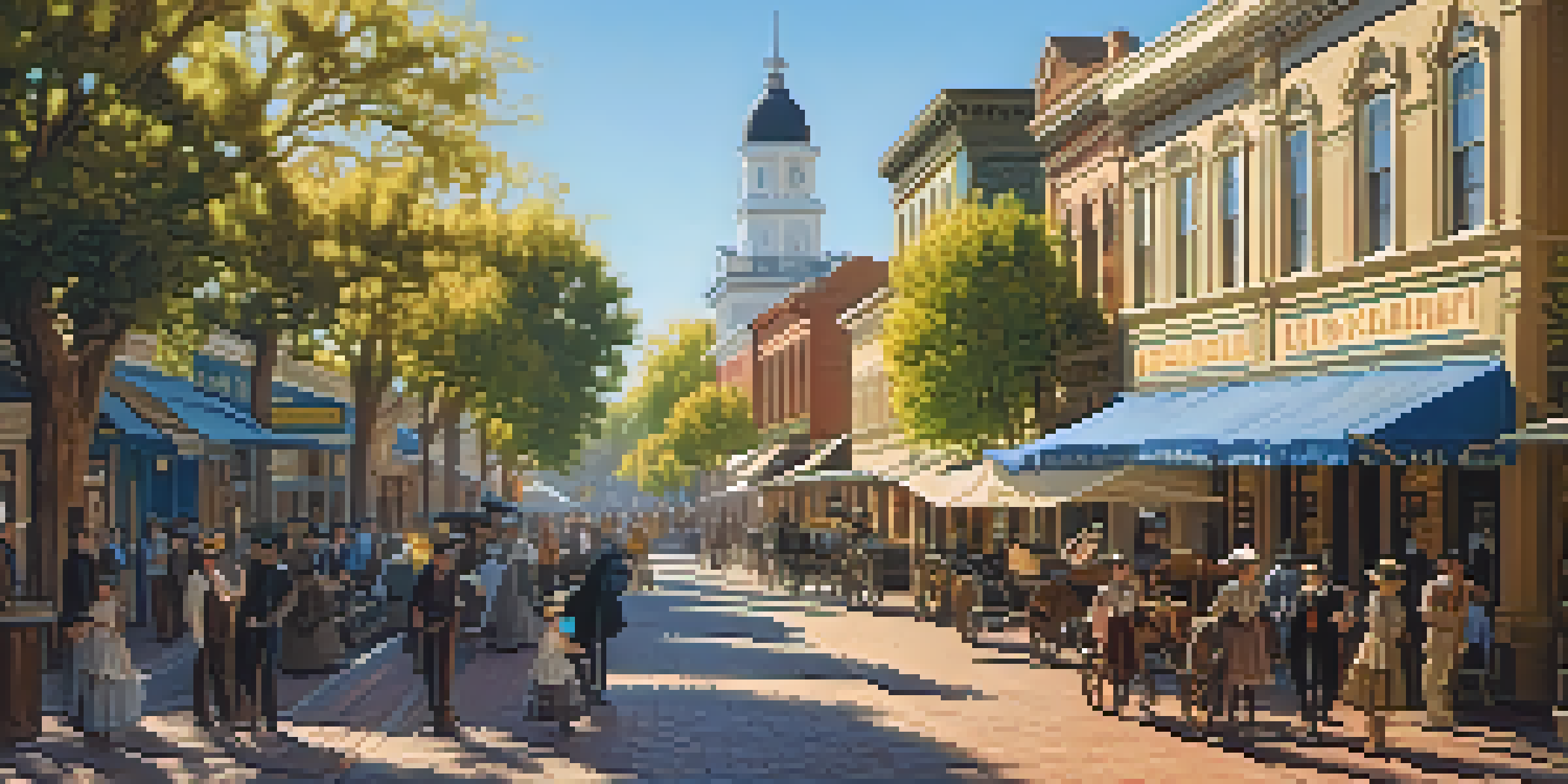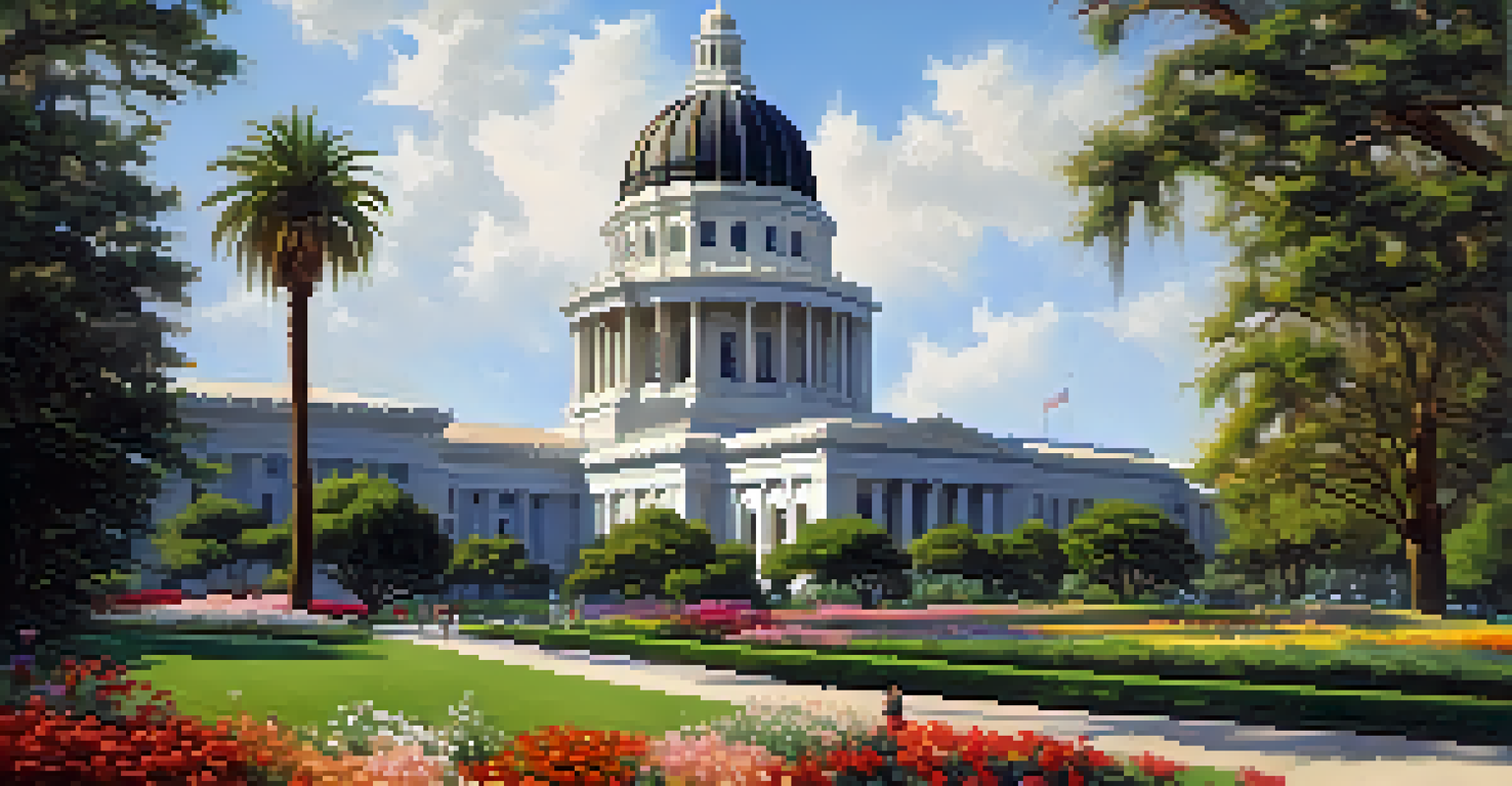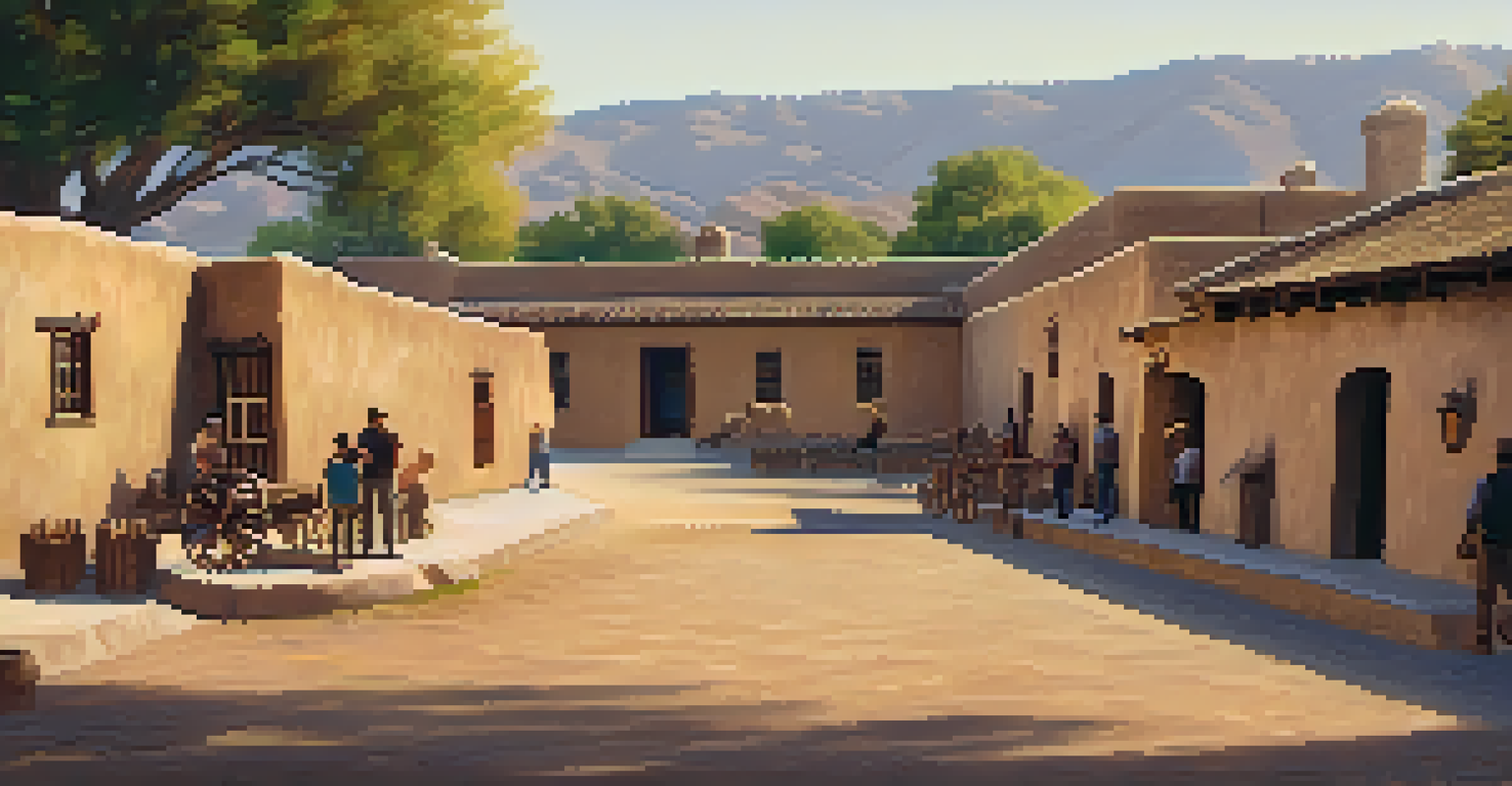Sacramento's Historic Landmarks: A Journey Through Time

The Gold Rush Era: Sacramento's Birthplace
Sacramento's history is deeply intertwined with the Gold Rush of 1849, a time that transformed the city from a sleepy river port to a bustling hub of commerce and culture. This period marked the beginning of Sacramento's rapid growth as thousands flocked to the area in search of fortune. The discovery of gold in the nearby Sierra Nevada foothills brought an influx of people, creating a melting pot of cultures and ambitions.
History is not a mere chronology of events; it is the spirit of a people, their struggles and triumphs, captured in the stories we tell.
Today, you can visit Old Sacramento, where wooden sidewalks and historic buildings transport you back to the Gold Rush days. The area is home to numerous museums and guided tours that tell the stories of those who lived and worked during this pivotal time. Engaging in these experiences not only enriches your understanding of Sacramento's past but also highlights the resilience of its early settlers.
As you stroll through the cobblestone streets, you can almost hear the echoes of miners and merchants negotiating their fortunes. This vibrant backdrop serves as a reminder of how Sacramento's spirit was shaped by the dreams and struggles of its early inhabitants, making the Gold Rush era a cornerstone of the city's identity.
The State Capitol: A Symbol of Governance
The California State Capitol stands as a testament to the state's political history and architectural beauty. Completed in 1874, this iconic building not only houses the offices of the Governor and the legislature but also serves as a museum that showcases California's rich heritage. Visitors are often struck by the impressive rotunda and the lush gardens that surround the Capitol, making it a perfect spot for a leisurely stroll.

Inside, you can explore various exhibits that delve into the state's history, from the Gold Rush to the present day. Guided tours are available, providing insights into the building's design and the important legislation that has taken place within its walls. This blend of functionality and beauty makes the State Capitol a key landmark that embodies the essence of Sacramento's governance.
Sacramento's Gold Rush Transformation
The Gold Rush of 1849 turned Sacramento from a quiet port into a thriving cultural and commercial hub as thousands sought fortune.
Whether you're a history buff or simply curious about California's political landscape, the State Capitol offers a unique perspective on how the state's past continues to influence its future. It's a must-visit for anyone looking to understand the heart of Sacramento's civic life and its role in shaping California.
Sutter's Fort: A Pioneer Legacy
Sutter's Fort is often considered the birthplace of Sacramento, and for good reason. Established in 1839 by John Sutter, this fort served as a trading post and refuge for pioneers venturing into the unknown territories of California. Today, Sutter's Fort is a state historic park, allowing visitors to step into the shoes of early settlers and experience life during the days of westward expansion.
Preservation of our heritage is not just about protecting buildings; it's about keeping alive the stories and memories that shape our identity.
The fort's adobe walls and recreated buildings give a vivid glimpse into the past, making it an educational and engaging destination for families and history enthusiasts alike. Interactive exhibits and reenactments bring history to life, providing context for the challenges faced by those who settled in this rugged landscape. It's a perfect example of how Sacramento's history is preserved and celebrated.
As you explore Sutter's Fort, you'll find yourself reflecting on the courage and determination of the pioneers who laid the groundwork for future generations. This landmark not only highlights Sacramento's role in the westward movement but also serves as a reminder of the rich tapestry of stories that shape the city today.
The Historic Tower Bridge: A Structural Marvel
The Tower Bridge is one of Sacramento's most recognizable landmarks, connecting the city to West Sacramento across the Sacramento River. Opened in 1935, this stunning bascule bridge is not only an essential transportation link but also a symbol of the city's architectural heritage. Its striking gold color and Art Deco design make it a favorite spot for photographers and visitors alike.
Walking across the bridge offers breathtaking views of the river and the skyline, making it an ideal location for a leisurely stroll or a quick bike ride. As you take in the scenery, it's easy to appreciate the engineering marvel that has stood the test of time while facilitating the flow of goods and people between the two cities. The bridge is often illuminated at night, creating a magical atmosphere that captures the essence of Sacramento.
Historic Sites Reflect Sacramento's Past
Landmarks like Sutter's Fort and the Historic Governor's Mansion offer visitors a glimpse into the city's rich history and pioneer legacy.
The Tower Bridge is more than just a means of crossing the river; it's a gateway to exploring the vibrant communities on either side. Whether you're interested in history, architecture, or simply enjoying the outdoors, a visit to this landmark enriches your understanding of Sacramento's development over the years.
The Historic Old Sacramento Waterfront
The Old Sacramento Waterfront is a vibrant district that transports visitors back to the 19th century, complete with wooden sidewalks and historic buildings. This area played a crucial role during the Gold Rush, serving as a bustling port for steamboats and traders. Today, it stands as a testament to the city's rich maritime history and offers a unique blend of shopping, dining, and entertainment.
As you explore the waterfront, you'll discover a variety of shops and restaurants that celebrate local flavors and crafts. The area is also home to museums, including the California State Railroad Museum, which showcases the impact of railroads on California's growth. Walking along the riverfront, you can almost hear the stories of the merchants and adventurers who once frequented the same paths.
The Old Sacramento Waterfront is not just a historical site; it's a lively community hub that hosts events and festivals throughout the year. Whether you're enjoying a summer evening concert or browsing a local artisan market, this bustling area highlights Sacramento's commitment to preserving its history while embracing modern culture.
The Crocker Art Museum: A Cultural Oasis
The Crocker Art Museum is a gem in Sacramento's cultural landscape, renowned for its impressive collection of California art and European masterpieces. Established in 1885, it is one of the oldest art museums in the West and has undergone significant expansions to accommodate its growing collection. The museum's architecture beautifully blends historic and contemporary styles, creating a welcoming space for art lovers and casual visitors alike.
Inside, you'll find works ranging from the 19th-century California Impressionists to contemporary artists, making it a diverse and enriching experience. The museum also hosts rotating exhibitions, educational programs, and special events, ensuring there's always something new to discover. A visit to the Crocker is not just about viewing art; it's an invitation to engage with creativity and culture.
Cultural Attractions Enrich the City
Museums such as the Crocker Art Museum and the California State Railroad Museum celebrate Sacramento's artistic and historical significance.
The museum's gardens and outdoor spaces provide a tranquil escape in the heart of the city, making it an ideal spot for reflection. Whether you're an art aficionado or someone looking to spend a pleasant afternoon, the Crocker Art Museum offers a unique perspective on Sacramento's artistic heritage and its vibrant community.
The Historic Governor's Mansion: A Glimpse into the Past
The Historic Governor's Mansion is a stunning example of Victorian architecture and a significant piece of California's political history. Built in 1877, this mansion served as the official residence for California governors for over a century. Today, it functions as a museum, inviting guests to explore its beautifully restored rooms and gardens, which reflect the opulence of the era.
Visitors can take guided tours that highlight the mansion's rich history, including stories of the governors and their families who once called it home. The tour offers a glimpse into the personal lives of these political figures, showcasing the mansion's role in California's governance and social events. The blend of history and architecture provides a fascinating context for understanding the state's political landscape.

As you wander through the manicured gardens, it's easy to appreciate the careful preservation of this historic landmark. The Governor's Mansion stands not only as a symbol of political power but also as a reminder of the importance of history in shaping our present. It's a must-visit for anyone looking to delve deeper into Sacramento's past.
Fort Sutter: The Roots of Sacramento's History
Fort Sutter, established in 1840 by John Sutter, played a pivotal role in Sacramento's early history. This fort served as a base for settlers and traders and became a refuge during the tumultuous Gold Rush era. Today, visitors can explore the archaeological remains of the fort, which are now part of a historic site that preserves its rich legacy.
The site offers interpretive signage and guided tours that delve into the fort's significance and the daily lives of those who lived there. Walking through the remnants of the fort, you can almost feel the spirit of those early pioneers who laid the foundation for what Sacramento would become. The experience is both educational and reflective, encouraging visitors to appreciate the challenges faced by the settlers.
Fort Sutter stands as a reminder of the resilience and determination that characterized Sacramento's early days. It's a place where history comes alive, allowing you to connect with the past and understand the roots of this vibrant city. A visit here is a journey through time, highlighting the importance of preserving our historical landmarks.